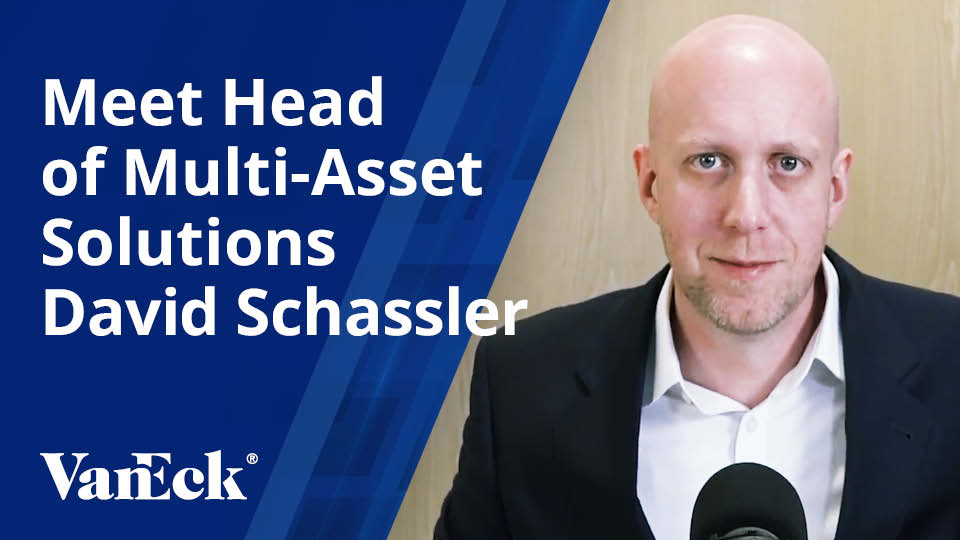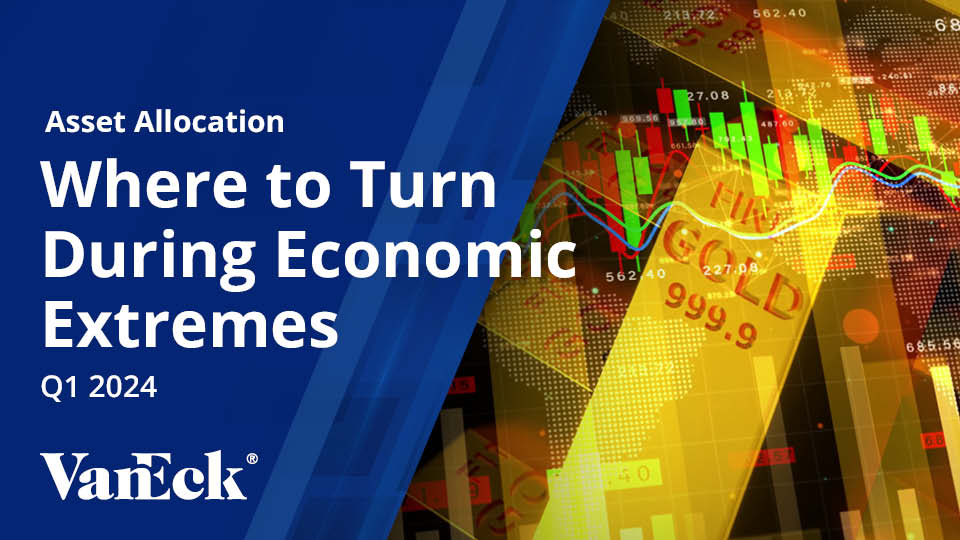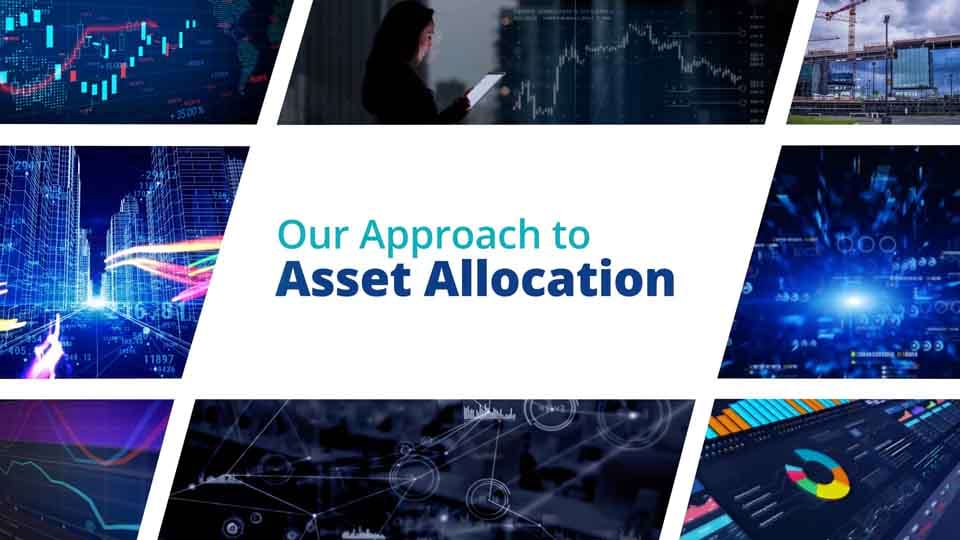How to Invest for Inflation Protection
March 09, 2022
Watch Time 6:47 MIN
Jenna Dagenhart: Joining us now to talk about inflation and the good, the bad, and the ugly is David Schassler, Portfolio Manager and Head of Multi-Asset Solutions at VanEck. Dave, great to have you with us. What are your current thoughts on inflation and the path forward from here?
David Schassler: Yeah. So, thank you very much for having us. Our thoughts on inflation, I think have been pretty consistent from the beginning. That thought is really that extreme monetary and fiscal policy would lead to inflation. You couple that with extreme supply chain issues, and here we are with really high inflation—highest inflation that we've seen really since the past 40 years. Now, our thoughts about inflation going forward: Our biggest risk right now is that we become entrenched. The psychology of inflation is setting in, and it's changing how people react to it. And one of the biggest risks right now is wage-price inflation. So, it risks us running this wage-price spiral, which is basically the situation where employees ask for higher wages. The employer gives those wages, then passes that on to their end consumer and oh, by the way, that employee now has more money to spend.
David Schassler: So, that's the risk where we are. Just to think about our thoughts on inflation going forward and what that's going to look like. I think that we were pretty lucky in the sense for the previous decade leading really up to 2020, where we had abnormally low inflation. The inflation rate was 1.8%. If I go back and I look at a very long-term view on inflation, that number is higher than 3%, probably close to around 3.2%. So, what I'm saying is that the anomaly was leading into this decade, how low inflation was. So, our thought is really that the next decade ahead, if we're lucky enough to be having this conversation, the forward looking, the average inflation rate would be significantly higher than 1.8%. And if that's the case, it would have a profound impact on the investment climate.
Jenna Dagenhart: And now here we are with inflation, the highest it's been since the 1980s, and the Fed (Federal Reserve) has recently communicated a more hawkish tone in response to that. How will this impact the situation?
David Schassler: The Fed is in a very tricky spot. So, instead of saying that the Fed is more or less put into a corner, we're saying the Fed has printed itself into a corner, meaning that there's just so much dead on the books right now. It gives them very little room to operate. Now, going back originally, when this first unfolded, we were told that we would get very mild and temporary inflation. What we got was harsh, persistent inflation. And that's where we sit. And the Fed is reacting to that. The Fed has changed their tone on inflation. They're sounding the alarms and saying that the risk to inflation is to the upside and acting accordingly. The risk right now is a policy mistake, a policy misstep. So, we have a situation where economic activity is declining, but they're looking at tightening going into it. So, it leaves us in a pretty vulnerable situation.
David Schassler: I think that the most likely base case scenario is that they're not too aggressive on inflation. That means that more or less inflation burns itself out over time, where the supply side catches up to the demand side, both kind of meet in the middle. And what that means is a prolonged period of higher inflation. There's also structural reasons why commodity prices would remain elevated as well, which then pushes inflation through the economy. So, we do think, again, going back to what I said before, we think the next decade ahead will bring significantly higher levels of inflation than we saw in the previous. But that's not really a bold statement given how low inflation was in the previous decade leading into this.
Jenna Dagenhart: Why do investors need to reconsider their portfolio allocations to offset inflation, and what asset classes can they look at for protection?
David Schassler: During periods of high inflation, traditional assets suffer, and real assets prosper. So, let me take you through that. When you have high inflation, think about it as a game of hot potato. And it's a game of hot potato that most traditional companies lose in the sense of the hot potato's inflation. And companies are trying to pass that along to consumers, as fast as they can without getting their hands burned by the hot potato. Now, inflation beneficiaries are the opposite. These are actually companies that can make more money, right? Or assets that can make more money during periods of high inflation. So, what we're talking about is commodities and companies related to commodities. So commodity prices—specifically commodities with high utilities—respond very, very quickly to supply/demand, imbalances. Now companies involved in the commodities businesses, natural resource equities, these are companies that typically benefit from higher inflation because commodity prices go up. So, they typically make a lot more money. So, your core assets during a period of high inflation would be that those that are tethered to commodity prices either directly or indirectly.
Jenna Dagenhart: And traditionally gold has been an inflation beneficiary, but a lot of people are disappointed right now. In the price of gold given inflation, what are your thoughts, Dave?
David Schassler: This is the classic playbook for gold. People shouldn't be really surprised. You could be disappointed, but I wouldn't be too surprised with how gold's responding. I'll take you through that. In the 1970s, and you saw it in the mid-2000s as well, gold historically responded on the second half of the inflation cycle. Why is that the case? Gold does not have the utility that other commodities have. People seek out gold as a store of value asset. What that means is people have to realize that they have an inflation problem. And in the first half of the inflation cycle in the 1970s, and you saw it in the mid-2000s, it's very easy to deny inflation as a problem, simply because inflation is not something that people are used to. So, when you get high inflation, the first knee-jerk reaction is to deny it. Assume that it's going to go away. But now you find yourself multiple years into it.
David Schassler: Inflation pressures are mounting. They're very high. You've been dealing with this for an extended period of time. It's undeniable that there's an inflation problem. At this point, people seek out protection. They seek out gold as a store of value asset. We think that we're just entering that pivotal point where people are rethinking their views on inflation. Clearly central banks globally have, and consumers are as well. So, we think it's just a waiting time until gold really catches a bid. The last thing I'll say on that is that we are entering a very delicate spot for monetary policy in the sense of the chances of a misstep are pretty high. And that has the ability to pull forward gold as a safe-haven asset, because gold is typically looked as a safe-haven asset during periods of stress. So, if we get a policy misstep with rising expectations of inflation, I think you could see gold do really well.
Jenna Dagenhart: Well, Dave, thank you so much for joining us.
David Schassler: It was a great conversation. Thank you for having us.
Jenna Dagenhart: And thank you for watching. Once again, I was joined by Dave Schassler, Portfolio Manager and Head of Multi-Asset Solutions at VanEck. To receive regular updates from VanEck's experts, please visit vaneck.com/subscribe.
IMPORTANT DISCLOSURE
Please note that VanEck may offer investments products that invest in the asset class(es) or industries included in this video.
The views and opinions expressed are those of the speaker and are current as of the video’s posting date. Video commentaries are general in nature and should not be construed as investment advice. Certain statements contained herein may constitute projections, forecasts and other forward looking statements, which do not reflect actual results, are valid as of the date of this communication and subject to change without notice. Information provided by third party sources are believed to be reliable and have not been independently verified for accuracy or completeness and cannot be guaranteed. . VanEck does not guarantee the accuracy of 3rd party data. Any discussion of specific securities mentioned in the video is neither an offer to sell nor a recommendation to buy these securities.
All investing is subject to risk, including the possible loss of the money you invest. As with any investment strategy, there is no guarantee that investment objectives will be met and investors may lose money. Diversification does not ensure a profit or protect against a loss in a declining market. Past performance is no guarantee of future performance.
No part of this material may be reproduced in any form, or referred to in any other publication, without express written permission of Van Eck Securities Corporation.
© Van Eck Securities Corporation.
Van Eck Securities Corporation
666 Third Avenue, New York, NY 10017
Related Topics
Related Insights
February 28, 2024
February 22, 2024
December 19, 2023



